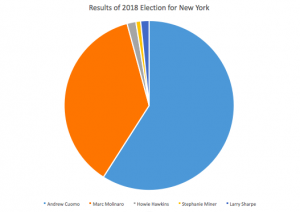In the year of 2018, Cuomo and Molinaro ran for governor. At first glance, one can look to their personal websites. For a first impression, Cuomo has more organized sections that can be scrolled over that state his beliefs, his dates for press conferences, etc. Molinaro is less organized on the website, but focuses a lot on donating, volunteering, and staying connected to him. The website shows that they are both involved in Facebook, Twitter, Instagram, and Youtube, seemingly displaying a wide array of online presence.
Looking closer to specifics of their social media, I looked to Twitter. Both candidates seem to post about 5 times a day, often reposting or liking posts that align to their interests. Their strategies seem to differ a lot on Twitter, however. Molinaro seems to post more emotional content, often including pictures of children, or even his own, in order to garner sympathy from his supporters. Cuomo tends to create more factual content, displaying what he plans or would like to get involved in. Andrew Cuomo has more online presence on Twitter, having 25.5K tweets and 852K followers while Molinaro has only 18.7K tweets and only 15.7K followers. In comparison, Cuomo gets more responses to his tweets and the followers seem to be more involved. Overall, both use Twitter for quick bursts of information and support for themselves, being more informal than other forms of social media.
Looking closer to a different form of social media, Facebook, the results are similar in that Cuomo has a larger following on his page. Both seem to post less on Facebook, about once a day in comparison to Twitter. The Facebook pages are more tailored to have comments and be an outlet for people to speak to each other rather than Twitter which is more informal. Cuomo is more backed on both forms.
A general trend is that Cuomo has more followings on the different online outlets. This obviously comes from the fact that Cuomo is the incumbent candidate and has been for a while. However, this exposes the reasons that the incumbent wins more often. The incumbent candidate is able to have built more continuous online presence in which additional people add to the followings from previous elections. It is quite interesting that different social medias are used in different ways that are tailored towards the audience of the social media platforms. Young people tend to be more on Twitter and like quick fast information opposed to Facebook which fosters an older audience that chats with one another in arguments. These different tactics obviously matter, as Cuomo has won for several elections.
One thing to consider is that an online presence is so difficult to gauge, especially after having read the article, Cambridge Analytica and the Secret Agenda of the Facebook Quiz. This article speaks about the methods in which personalities of people are marked, watched, and used to target dark posts and even normal posts towards certain audiences. The fact that Cuomo is involved with Working Families, Independents, and Woman Equality may be relevant as these audiences may be getting either more negative news on Molinaro and more positive on Cuomo. Personally, I have only really seen Cuomo be involved and have not known about Molinaro until doing research. This is important to note that the online presences of these candidates is very tricky because I am most likely not able to see all the sides, articles, and posts from each candidate. It is scary to see that it is becoming harder and harder to predict the outcomes of these elections because of this. The success is often measured by the public by comments made by candidates and actions done, but how can we know what to trust?
Below, are the actual results of the votes in 2018 in correlation to the fact that Cuomo seemed to have a larger online presence.
https://molinaroforny.com
https://www.governor.ny.gov/about

